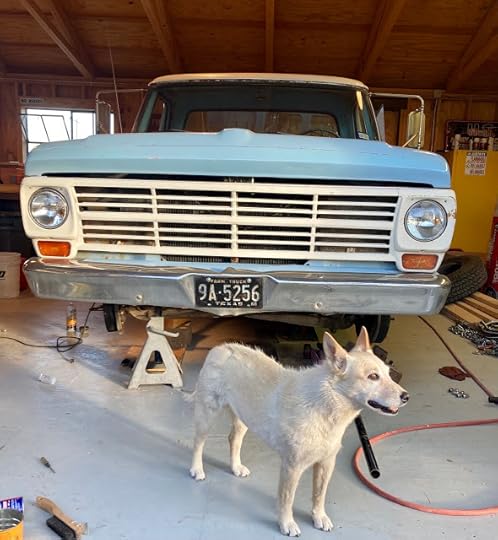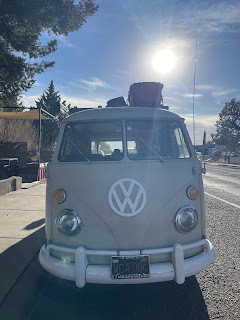Peter Behrens's Blog, page 89
April 15, 2023
1975 Chevrolet Suburban
 Gauley's Bridge, W. Va. David Branch was on the road from Marfa, Texas to Virginia in his 1975 Chevrolet Suburban last summer.
Gauley's Bridge, W. Va. David Branch was on the road from Marfa, Texas to Virginia in his 1975 Chevrolet Suburban last summer.
Published on April 15, 2023 02:00
April 13, 2023
1993 GMC Sonoma pickup
Published on April 13, 2023 06:06
April 12, 2023
1968 Ford F-100 delivery. Texas.
Published on April 12, 2023 06:11
April 11, 2023
1977 Chevrolet C-10 Marfa, Texas.
 David Branch photos. And we have posted on much of the Marfa truck herd, including out own favorite 1986 SWB C-10.
David Branch photos. And we have posted on much of the Marfa truck herd, including out own favorite 1986 SWB C-10.
Published on April 11, 2023 03:30
April 10, 2023
Surfer Bus. Carpinteria, Calif.
Published on April 10, 2023 04:00
April 9, 2023
Mercedes Benz 300 TD wagon, Harvard Square.
 We caught a very similar M-B TD wagon in Cambridge a couple years ago. And a Mercedes Benz 230 TE wagon, same era in Frankfurt. Another 300 TD for sale in Maine a whielback. Another Mercedes Benz 300 TD wagon in Brooklin, Maine. Lots of clunky style and they'll go forever, or for as long as you can afford diesel fuel.
We caught a very similar M-B TD wagon in Cambridge a couple years ago. And a Mercedes Benz 230 TE wagon, same era in Frankfurt. Another 300 TD for sale in Maine a whielback. Another Mercedes Benz 300 TD wagon in Brooklin, Maine. Lots of clunky style and they'll go forever, or for as long as you can afford diesel fuel.



Published on April 09, 2023 03:00
April 8, 2023
1962 Rambler American. Santa Barbara, Calif.
 Unrestored original. The metal strips atop the window frames..perhaps deflected the wind on the Pasadena Freeway when cranking alone with windows down at...what? 60mph? The American has a kinda Volvo 240 look, doesn't it? We posted The Rambler, the Sommelier and You by Bruce Willard a while back. The Rambler American got a major makeover, a year or so later: we posted a 1964 Rambler American 440. And we caught a couple of Ramblers living rough on Deer Isle a while back. And an Ambassadorship for sale in Ellsworth Maine.
Unrestored original. The metal strips atop the window frames..perhaps deflected the wind on the Pasadena Freeway when cranking alone with windows down at...what? 60mph? The American has a kinda Volvo 240 look, doesn't it? We posted The Rambler, the Sommelier and You by Bruce Willard a while back. The Rambler American got a major makeover, a year or so later: we posted a 1964 Rambler American 440. And we caught a couple of Ramblers living rough on Deer Isle a while back. And an Ambassadorship for sale in Ellsworth Maine.






Published on April 08, 2023 03:00
April 7, 2023
Eva H.D., The Natural Hustle, and Rivers of Morning in America
 Our sometime contributor Eva H.D.'s third collection of poems, The Natural Hustle, is just out from McClelland & Stewart/Penguinrandomhouse.ca.
Our sometime contributor Eva H.D.'s third collection of poems, The Natural Hustle, is just out from McClelland & Stewart/Penguinrandomhouse.ca.


Published on April 07, 2023 15:00
c. 1966 Volkswagen Type 2 bus. Marfa, Texas.
Published on April 07, 2023 04:00
April 6, 2023
Going Postal

From the whyisthisinteresting substack, back in October 2021:
The author Reilly Brennan (RPB) is a partner at Trucks Venture Capital and an adjunct professor at Stanford University.
While U.S. election vote-by-mail deadlines vary by state, many millions have already been received, and some already counted. It is likely that 2020’s mail-in total will be significant—estimates are as high as 80 million ballots, or double the number from 2016.
Consider your ballot, swaddled in its 28 lb. cardstock envelope, making its historic voyage from your kitchen table to your state’s tabulation center. It’s arguably your most important trip of the year, and in keeping with the times, you’ll have to remain at home in athleisure while logistics professionals handle the hard work. Most of those ballots will travel all or part of their journey in trapezoidal marshmallow shuttles known as USPS mail trucks.
Why is this interesting?
The mail truck is everywhere. It moves 500 million pieces of mail per day to 160 million addresses. It’s also quite old and overdue for an upgrade: today’s fleet of 100,000 USPS mail trucks has an average age of nearly 30 years.
The little trucks are still running because they were built that way. Defense contractor Grumman designed them in the mid-1980s on top of a 1982 Chevy pickup truck engine and chassis, naming it the LLV, or long-life vehicle. This was a new idea. Prior postal vehicles were mostly standard Jeeps, but the new-for-1987 LLV married a custom design on top with a simple truck underneath. Replacement parts were already available nationwide via GM’s vast dealer network.
That design pragmatism prioritized the service and repair of the vehicle, but in exchange mostly neglected the operator. The LLV arrived with no air conditioning, airbags, anti-lock brakes, or even shelves in the rear cargo area. The truck averages 10 miles-per-gallon with standard gasoline, translating into somewhere approaching $1B per year in fuel costs, the largest burn of any civilian fleet in the nation.
Reliable design insights about the vehicle’s problems are best found on letter carrier message boards and aftermarket parts retailers. The LLV has terrible traction in the winter, so drivers put bags of sand in the back or buy these jigsaw weights and lay them across the cargo area. To combat the summer heat, carriers buy tiny fans or drive their vehicles into friendly meat lockers during their lunch break.
A walking tour of the common postal truck reveals unusual decisions and a few hidden secrets.

From left: A) mail trucks have no license plate, but each has a registration number: the first digit indicates the year the vehicle was produced in the range from 1987-1994, which is why you’ll never see a mail truck with a registration number beginning with a 5 or 6. B) Mail truck enthusiasts have wondered for decades if the USPS logo matched the vehicle’s rear body angle. Unfortunately and frustratingly, the answer is no. C) As right-hand drive vehicles with poor rearward visibility, designers attempted to reduce reverse maneuvers by creating a tighter turning radius. This was done by making the front wheel track narrower than the rear--" (BTW, from AL: did you see our Trust Woman postal jeep a couple weeks back?)
--"It’s clear that a new vehicle is needed. A few prototypes are underway after USPS first opened up a call for entries in 2015 for a “Next Generation Delivery Vehicle,” but budget delays pushed a contract decision back to sometime within the next year—maybe. Today’s fleet is so old it’s more costly each passing day, and some vehicles are catching fire unexpectedly.

I would echo this call from David Roberts to build the next fleet with electric powertrains—it would reduce both maintenance and fuel costs. Doing so would also keep pace with Amazon’s plan to electrify its fleet using new vans built by the Michigan startup Rivian. Other interesting ideas include equipping the go-anywhere vehicles with cameras to create a mapping/streetview database that would make Google’s offering feel like media mail.
The next postal vehicle is almost here. Until then let’s appreciate how 2020's unusual, confusing, and problematic election cycle had a most appropriate chariot.
Published on April 06, 2023 03:30















